Part of Indonesia’s top diving destinations, Komodo diving is done in the Komodo National Park, a UNESCO World Heritage Site that offers some of the most vibrant and diverse marine life on the planet.
Komodo diving is all about crystal-clear waters, stunning coral reefs, and an abundance of marine species. In this comprehensive guide, we will explore everything you need to know about scuba diving in Komodo, from the best dive sites and marine life to essential travel tips.
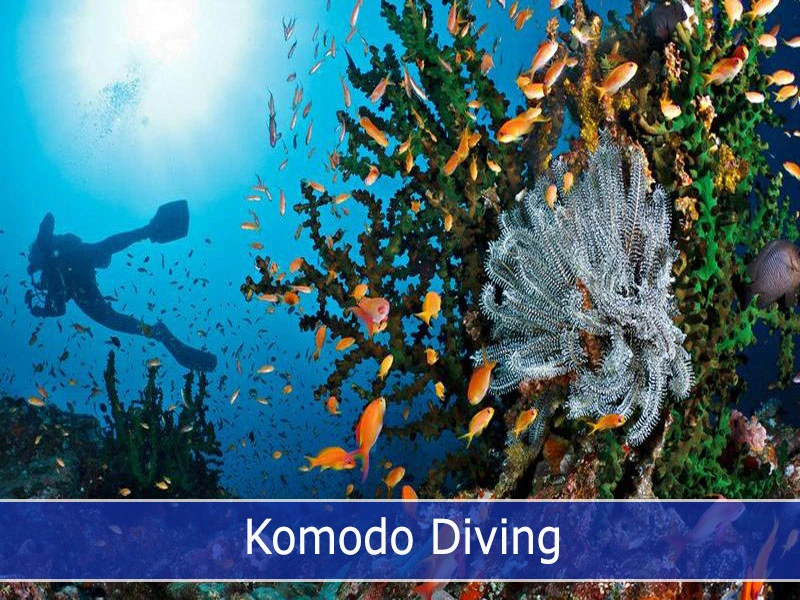

Contents
An Overview of Komodo Diving
The Komodo National Park was established in 1980 and consists of three major islands: Komodo, Rinca, and Padar islands, along with numerous smaller islands. The park covers over 1,733 square kilometers, with around 603 square kilometers of marine protected area, making it an excellent destination for a dive trip.
With our very own Komodo Resort and Neptune Scuba Diving Komodo, we offer divers the unique opportunity to explore this diverse underwater world, characterized by colorful coral gardens, deep walls, and thrilling drift dives. Manta Rays, Mobula Rays, Eagle Rays, different types of sharks, these are just a few of the things that make Komodo scuba diving so attractive.
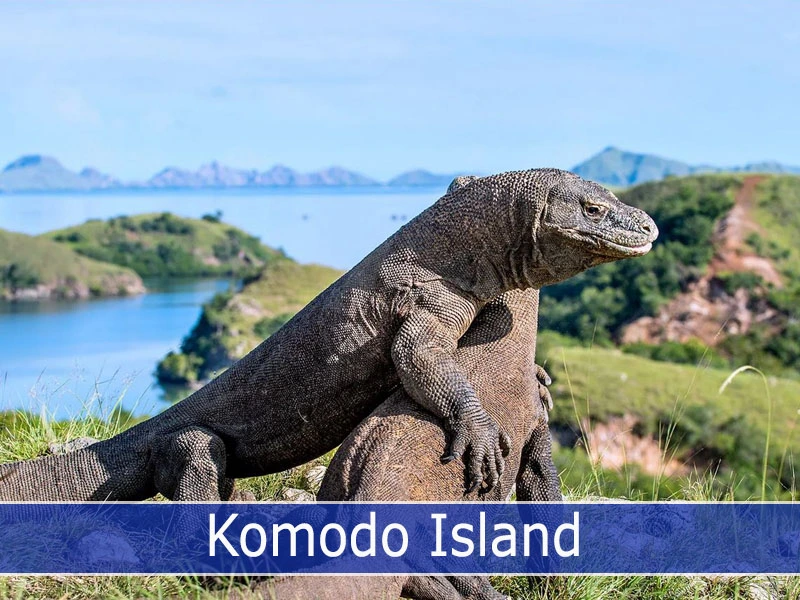
Komodo Island
Komodo Island is a small but captivating island located in the Indonesian archipelago. Known worldwide for its famous inhabitants, the Komodo dragons, the island offers a unique and unparalleled wildlife experience. These giant reptiles, with their impressive size and ancient appearance, draw countless visitors each year. Apart from the Komodo dragons, Komodo island is blessed with diverse ecosystems, including pristine beaches, dense forests, and vibrant coral reefs, making it a haven for nature lovers and adventure seekers.
Beyond its natural wonders, Komodo Island also holds cultural significance. The local communities on the island, predominantly the Komodo people, have a rich heritage and traditional way of life. Visitors have the opportunity to interact with the locals and learn about their customs, beliefs, and traditional craftsmanship. This cultural immersion adds depth to the overall experience and offers a glimpse into the island’s fascinating past.
The fragile ecosystem is under threat due to human activities, including unsustainable tourism practices and habitat destruction. To safeguard the island’s natural and cultural heritage, efforts are being made by local authorities and organizations to promote sustainable tourism, implement conservation measures, and raise awareness about the importance of preserving this extraordinary destination.
Komodo Island is a captivating gem that combines awe-inspiring wildlife, breathtaking landscapes, and a rich cultural heritage. Whether it’s exploring the rugged terrains in search of Komodo dragons, diving into the crystal-clear waters teeming with marine life, or immersing oneself in the local traditions, Komodo Island promises an unforgettable and enlightening experience for all who venture to its shores.

Rinca Island
Rinca Island is a captivating destination located in the Indonesian archipelago, renowned for its natural beauty and rich biodiversity. The island, part of Komodo National Park, offers visitors a unique opportunity to witness the famous Komodo dragons in their natural habitat. These awe-inspiring creatures, the largest species of lizard in the world, roam freely on Rinca Island, providing an incredible wildlife encounter.
The island’s diverse landscape, comprising rolling hills, savannahs, and pristine beaches, adds to its allure, creating a picturesque setting for exploration and adventure. Stepping foot on Rinca Island feels like entering a prehistoric world, where visitors can embark on guided tours to observe the fascinating behavior of the Komodo dragons. Trained park rangers accompany visitors, ensuring their safety while providing valuable insights into the behavior and conservation efforts surrounding these ancient reptiles.
The island’s compact size makes it easier for visitors to spot Komodo dragons, increasing the chances of close encounters and memorable experiences. Aside from the remarkable wildlife, Rinca Island also offers breathtaking vistas and opportunities for outdoor activities. The island’s scenic trekking trails lead visitors through rugged terrain, rewarding them with panoramic views of the surrounding turquoise waters and lush landscapes.
Rinca Island is a captivating destination located in the Indonesian archipelago, renowned for its natural beauty and rich biodiversity. The island, part of Komodo National Park, offers visitors a unique opportunity to witness the famous Komodo dragons in their natural habitat. These awe-inspiring creatures, the largest species of lizard in the world, roam freely on Rinca Island, providing an incredible wildlife encounter.
The island’s diverse landscape, comprising rolling hills, savannahs, and pristine beaches, adds to its allure, creating a picturesque setting for exploration and adventure. Stepping foot on Rinca Island feels like entering a prehistoric world, where visitors can embark on guided tours to observe the fascinating behavior of the Komodo dragons. Trained park rangers accompany visitors, ensuring their safety while providing valuable insights into the behavior and conservation efforts surrounding these ancient reptiles.
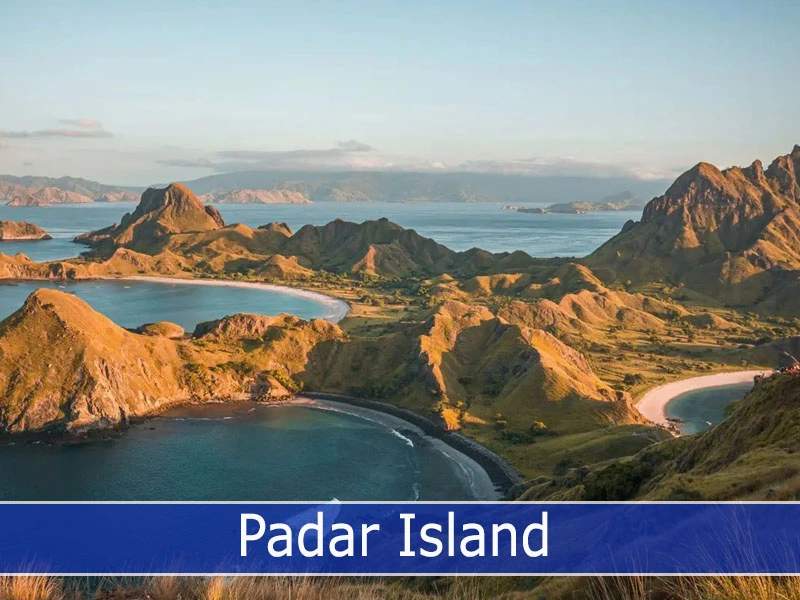
Padar Island
Padar Island is a mesmerizing gem nestled in the Komodo National Park, Indonesia. With its unique and diverse landscape, this small but enchanting island offers an unforgettable adventure for nature lovers and photographers alike.
Surrounded by turquoise waters, Padar Island is renowned for its distinctively shaped hills that display a breathtaking gradient of colors, ranging from golden sands to lush green vegetation.
Visitors can embark on a moderate hike to reach the island’s highest viewpoint, which rewards them with panoramic vistas of the surrounding islands and pristine beaches below.
As part of the UNESCO World Heritage Site, Padar Island boasts an incredibly diverse ecosystem. Its untouched beaches and crystal-clear waters are home to a variety of marine life, including vibrant coral reefs, exotic fish species, and even occasional encounters with manta rays and dolphins.
The island’s rich biodiversity extends to the land, where visitors can spot Komodo dragons, the world’s largest lizards, along with other fascinating wildlife such as wild boars, deer, and various bird species.
Beyond its natural splendor, Padar Island offers a tranquil and secluded atmosphere, perfect for those seeking a peaceful retreat. The island’s untouched and unspoiled environment allows visitors to truly disconnect from the outside world and immerse themselves in the serenity of nature.
The Best Dive Sites for Komodo Diving
When it comes to diving in Komodo, divers are spoiled with over 50 dive sites to choose from. Each dive site is unique, some with strong currents, some gentle drifts while some are simply stunning coral reefs. Here are some of the most popular dive sites divers must absolutely visit:
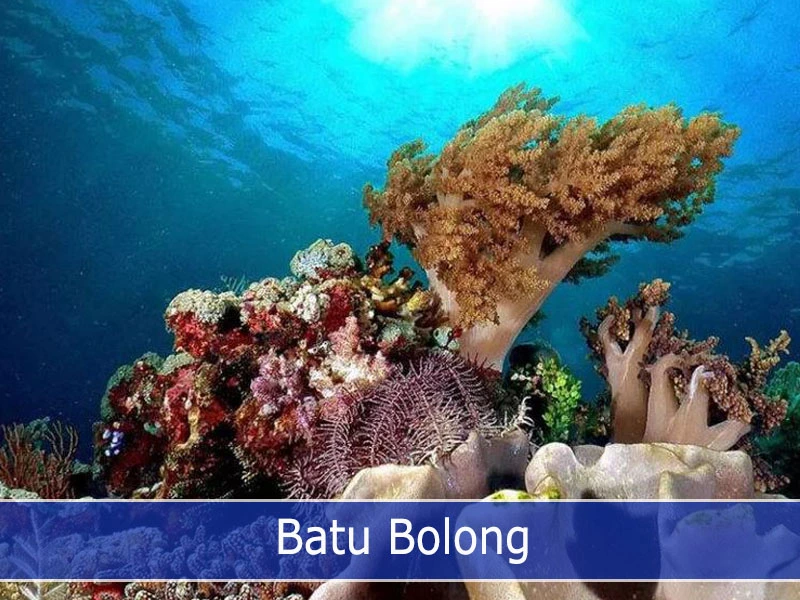
Batu Bolong
Batu Bolong is Komodo’s most iconic dive site, offering a variety of exhilarating experiences for divers. One such adventure is drift diving, where divers can explore the pinnacle while being carried along by the ocean currents. The strong currents make this dive thrilling and provide an opportunity to observe vibrant corals and diverse marine life, such as reef sharks, turtles, and large schools of fish. Additionally, Batu Bolong offers the unique opportunity for a night dive, allowing divers to witness a different world come alive under the cover of darkness. Night dives reveal nocturnal creatures, mesmerizing bioluminescence, and a whole new perspective of the dive site’s beauty.
Typically a zig zag dive, divers visiting Batu Bolong must be at least Advanced Open Water certified and with minimum 30-40 dives. This is because sometimes currents in Batu Bolong can be extremely strong which also makes timing a very important factor.
Although most often the dive plan should take us to Batu Bolong, sometimes the dive must be cancelled due to strong currents very clearly visible from the surface.
Maximum depth: 30m+ / 98 feet
Temperature: 27 to 29 Celsius / 80F to 84F
Currents: Often strong, requires planning
Minimum experience: Advanced Open Water
Visibility: Varies, can be excellent on calm days
Best time to dive: Year-round, but April to October is recommended for better conditions
As divers descend into the waters of Batu Bolong, they are greeted with a breathtaking underwater landscape. The pinnacle rises from the depths, covered in a kaleidoscope of colorful corals, creating a stunning backdrop for the abundant marine life in the area.
Reef sharks, including whitetip and blacktip sharks, can often be spotted cruising along the reef, adding an exhilarating element to the dive. Turtles gracefully swim by, their shells glinting in the sunlight, while large schools of fish dance through the water in a mesmerizing display.
The currents at Batu Bolong can be intense, requiring careful planning and timing for a safe and enjoyable dive. Divers must have the necessary experience and skills to navigate these conditions. The zigzag pattern is commonly used to navigate the site, allowing divers to make the most of the changing currents and explore the different sections of the pinnacle.
Visibility at Batu Bolong can vary, with excellent conditions on calm days offering crystal-clear waters that provide remarkable visibility. However, on days with stronger currents or increased sedimentation, the visibility may be reduced.
However, weather and sea conditions can be unpredictable, so it’s always advisable to check with local dive operators for the most up-to-date information before planning a dive.
Batu Bolong is a dive site that captivates divers with its vibrant underwater scenery and diverse marine life. It offers an unforgettable experience for those who are prepared to meet the challenges of the currents and are enchanted by its beauty.

Manta Point
The name says it all, Manta Point is the place to be for divers who want to dive with the majestic Manta Rays on their next dive trip. It’s not an everyday guarantee to see the Manta ray, but we can say there are 80% chances to see them.
Manta Point offers an exhilarating drift diving experience, including a thrilling night dive where you can glide along the currents while exploring the rocky sandy bottom and eventually ending up on a mesmerizing rock and coral formation. Additionally, Manta Point is also a fantastic spot for thrilling wall dives, allowing you to witness the fascinating nocturnal marine life in action.
Manta Point is not the only dive site in the Komodo National Park to see the Manta ray. The other dive sites are Mawan and Manta Alley. Typically when there are no Mantas in this spot, they are most definitely in Mawan.
Maximum depth: 15m / 49 feet
Temperature: 27 to 29 Celsius / 80F to 84F
Currents: Drift, mild-strong
Minimum experience: Advanced Open Water
Diving in the Komodo National Park is an exhilarating experience for those who wish to encounter the magnificent Manta Rays. While sightings cannot be guaranteed every day, there is an estimated 80% chance of encountering these majestic creatures.
The dive in this area is characterized by a drift dive, where divers glide along the water’s current over a rocky sandy bottom. The dive culminates on top of a rock and coral formation, providing a stunning backdrop for observing marine life.
Although Manta Point is a popular dive site for encountering Mantas, it is not the only location within the Komodo National Park where these graceful creatures can be found. Other notable dive sites for Manta Ray encounters include Mawan and Manta Alley. When Mantas are not present, they are often sighted at Mawan, making it an excellent alternative for divers seeking these encounters.
Divers may also have the opportunity to spot other fascinating marine life that inhabits the Komodo National Park. From vibrant coral reefs to diverse fish species, the underwater ecosystem of this region is a sight to behold.
Exploring the depths of the surrounding dive sites offers a unique opportunity to witness the beauty and grace of Manta Rays in their natural habitat, making it an unforgettable experience for diving enthusiasts.

The Cauldron / Shotgun
Divers cannot visit Komodo for diving without trying The Claundron, also known as Shotgun. This is a unique dive site with an underwater channel that creates a swirling current, attracting large schools of fish and other marine life, often even Mantas but more often sharks.
As a drift dive, Shotgun is one of the most exciting dive sites in the Komodo National Park, drifting through the channel as a fast movie.
Maximum depth: 20m / 65 feet
Temperature: 26 to 28 Celsius / 78F to 82F
Current: Mild to strong
Minimum experience: Advanced Open Water
To dive at The Cauldron/Shotgun in Komodo National Park, divers must have an Advanced Open Water certification or higher. This certification indicates that divers have gained the necessary skills and knowledge to handle more challenging diving conditions, including navigating drift dives and managing stronger currents.
The Advanced Open Water certification builds upon the foundational skills learned in the Open Water course and expands divers’ abilities by introducing them to new diving environments and specialized techniques.
While specific certification requirements may vary among dive operators and dive centers, having an Advanced Open Water certification ensures that divers have received proper training to handle the unique conditions present at The Cauldron/Shotgun. This includes understanding how to plan and execute a drift dive, managing buoyancy and air consumption effectively, and having a good grasp of underwater navigation techniques.
Divers should always check with the dive operator or dive center they plan to dive with to confirm the certification requirements for The Cauldron/Shotgun. They may also consider refreshing their skills or taking additional specialty courses to enhance their diving abilities and maximize their enjoyment and safety at this thrilling dive site.
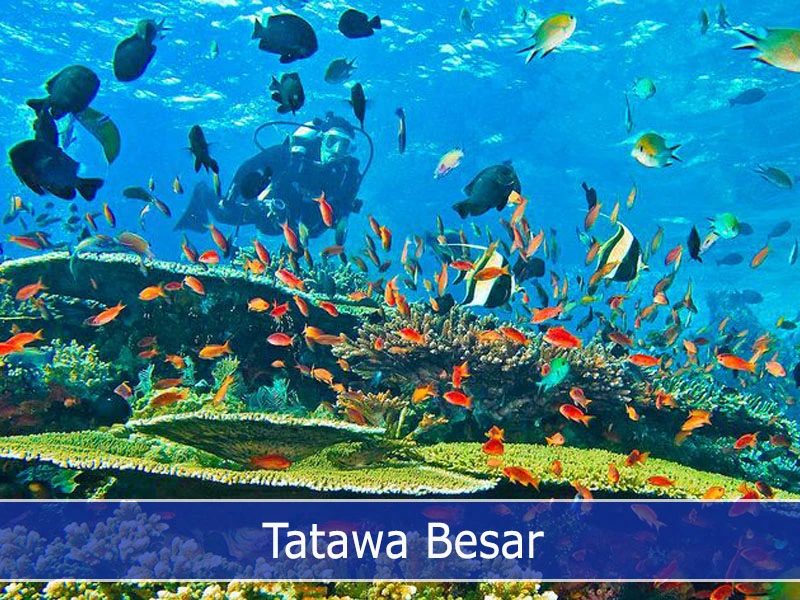
Tatawa Besar
Tatawa Besar has one of the most rich coral reefs of all of the Komodo diving. Typically a gentle drift, divers here can enjoy amazing underwater life and simply incredible coral reef that rivals any such dive site in the world.
Diving at Tatawa Besar is good all year round and when conditions are not good here, divers can move to the sister dive site called Tatawa Kecil.
Maximum depth: 30m / 98 feet
Temperature: 26 to 28 Celsius / 78F to 82F
Current: Mild
Minimum experience: Open Water
Tatawa Besar is a magnificent diving location known for its vibrant coral reefs and abundant marine life. With its gentle drift and stunning underwater scenery, it is considered one of the best diving sites in the Komodo region.
Divers can explore the incredible coral reef that stretches across Tatawa Besar, offering a visual feast of colors and shapes. The coral formations here are diverse and pristine, providing a home for numerous species of marine life. From colorful tropical fish darting in and out of the corals to majestic sea turtles gracefully gliding through the water, divers will be captivated by the beauty and diversity of the underwater ecosystem.
Tatawa Besar’s current is generally mild, making it an accessible dive site for divers of various skill levels. However, remaining aware of the conditions and following safety guidelines while diving is essential. Divers with an Open Water certification or higher will be able to enjoy the wonders of Tatawa Besar.
If conditions are unfavorable at Tatawa Besar, divers can visit Tatawa Kecil, its sister dive site. Tatawa Kecil offers unique underwater landscapes and marine species, ensuring divers have a rewarding experience regardless of the chosen dive site.
Whether you are an experienced diver or just starting your underwater adventures, Tatawa Besar promises an unforgettable diving experience with its stunning coral reefs, mild currents, and abundant marine life.
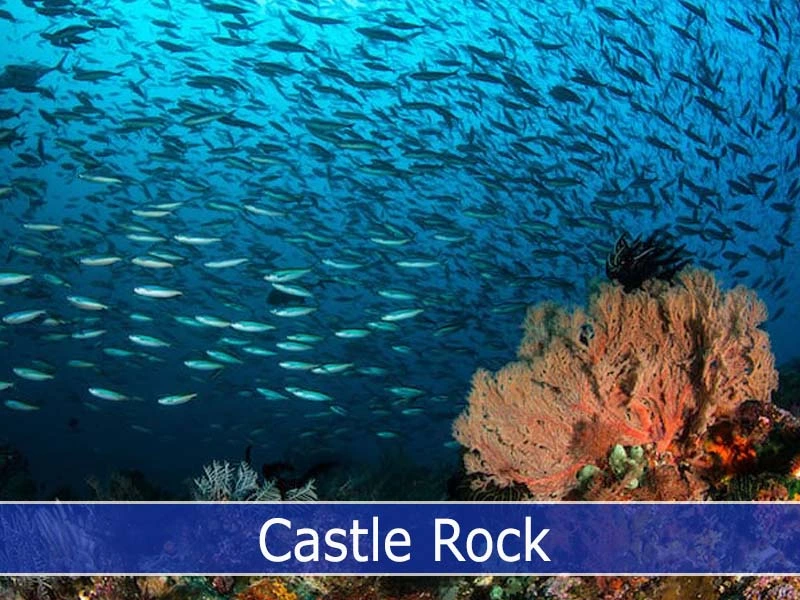
Castle Rock
Nestled amidst the rugged beauty of Indonesia’s stunning Komodo National Park, Castle Rock stands as a majestic testament to nature’s grandeur. This captivating island, adorned with lush greenery and pristine beaches, beckons adventurous souls seeking an extraordinary experience.
Home to the legendary Komodo dragons, Castle Rock unveils a world where ancient reptiles roam freely, and awe-inspiring marine wonders await beneath the turquoise waters.
A tropical paradise that enchants visitors with its untamed allure and rich biodiversity. As you set foot on this remote island in the Komodo archipelago, prepare to be captivated by its untouched landscapes and untamed wildlife.
Embark on unforgettable encounters with the formidable Komodo dragons, explore hidden coves teeming with vibrant coral reefs, and immerse yourself in the untamed splendor – where nature reigns supreme.
Maximum depth: 65 / 130 feet
Temperature: 25°C to 29°C / 77F to 84F
Current: Mild to strong
Minimum experience: Advanced Open Water
The dive site itself is a captivating spectacle, with its underwater formations and marine life. The area is renowned for its stunning coral reefs, which are home to a vast array of colorful fish species and other marine creatures. Schools of tropical fish dart through the coral gardens, creating a vibrant and bustling underwater scene.
One of the highlights of diving in this location is the opportunity to encounter the majestic Komodo dragons in their natural habitat. These ancient reptiles, known as the world’s largest lizards, can be seen both on land and occasionally swimming in the surrounding waters. Witnessing the Komodo dragons up close is a truly awe-inspiring experience and a rare opportunity to observe these fascinating creatures in their wild environment.
For those seeking an adrenaline rush, the strong currents attract pelagic species, including reef shark, giant trevally, and barracuda. These larger predatory fish are drawn to the area due to the abundant food supply provided by the strong currents. Diving alongside these magnificent creatures is a thrilling adventure that will leave a lasting impression.
To fully appreciate the wonders of this location, it is recommended to embark on guided dives led by experienced dive professionals who are familiar with the area’s unique conditions and marine life. They can ensure your safety while helping you navigate the currents and discover the hidden gems of this underwater paradise.
Whether you’re a seasoned diver or someone looking to take your diving skills to the next level, this place offers an extraordinary experience that combines the beauty of nature with the excitement of exploration. Prepare to be mesmerized by the untouched landscapes, encounter the mighty Komodo dragons, and immerse yourself in the untamed splendor that this location has to offer.
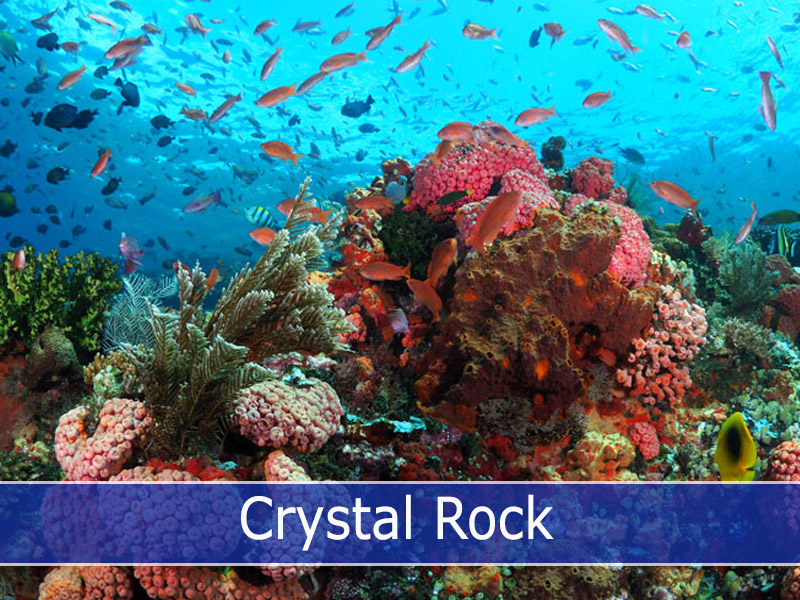
Crystal Rock
Crystal Rock is a stunning underwater cave system known for its crystal-clear water and unique rock formations. It is an adventurer’s paradise, offering an exhilarating diving experience for those who dare to explore its depths.
Maximum depth: 328 feet
Temperature: 20°C to 25°C / 68F to 77F
Current: Mild to strong
Minimum experience: Advanced Open Water
While exploring Crystal Rock, you’ll encounter a diverse array of marine life. Colorful coral reefs, vibrant fish, and other fascinating underwater creatures call this underwater cave system home. From delicate sea fans to elusive reef sharks, the biodiversity of Crystal Rock is sure to captivate any diving enthusiast.
It’s important to respect the fragile ecosystem of Crystal Rock and practice responsible diving. Avoid touching or damaging the rock formations and marine life, as they play a crucial role in the underwater ecosystem. By being mindful of your impact, you can help preserve this stunning dive site for future generations of divers to enjoy.
Crystal Rock offers a unique and unforgettable diving experience for advanced divers. Its crystal-clear waters, remarkable rock formations, and abundant marine life make it a must-visit destination for anyone seeking adventure beneath the waves. So gear up, dive in, and prepare to be amazed by the breathtaking beauty that Crystal Rock has to offer.
Beyond its natural wonders, Crystal Rock also holds a special place in the hearts of divers due to its sense of tranquility and serenity. As you descend into the depths, the outside world fades away, replaced by a profound stillness that is both calming and exhilarating. The weightlessness and silence envelop you, allowing you to truly immerse yourself in the moment and appreciate the raw beauty that surrounds you.
Whether you’re an experienced diver or a passionate adventurer seeking a new challenge, Crystal Rock beckons you to dive into its depths and uncover its secrets. It’s a place where exploration meets wonder, where the boundaries of imagination are pushed and new horizons are discovered. Crystal Rock is a testament to the breathtaking majesty of the natural world, and a reminder of our responsibility to protect and preserve the treasures that lie beneath the waves.
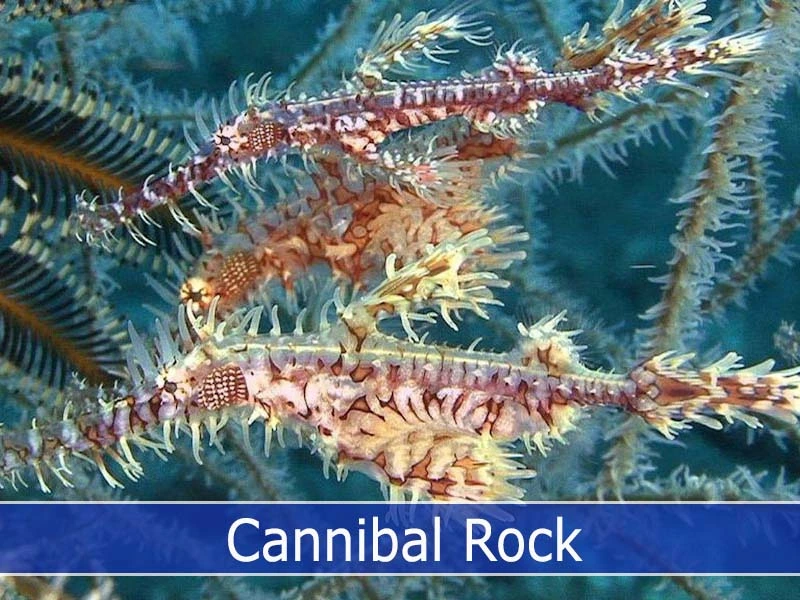
Cannibal Rock
Cannibal Rock is an awe-inspiring dive site located in the Komodo National Park, Indonesia. It is renowned for its stunning underwater topography, vibrant marine life, and challenging conditions. As an advanced diving destination, it requires divers to meet certain prerequisites before attempting a dive at this site.
Maximum depth: 98 feet
Temperature: 25°C to 29°C / 77F to 84F
Current: Strong
Minimum experience: Advanced Open Water
The vibrant marine biodiversity at Cannibal Rock is a highlight for divers. The rock formations are adorned with colorful soft corals, sponges, and sea fans, creating a stunning backdrop for underwater photography. Schools of fish, including fusiliers, snappers, and surgeonfish, can be observed swimming around the rock formations. Divers may also encounter manta ray or turtle, and even reef sharks.
For photographers, Cannibal Rock is a dream come true. Macro enthusiasts can spot a variety of critters hiding among the healthy coral, including pygmy seahorses, nudibranchs, and colorful mantis shrimp. The site is also known for its rich biodiversity, attracting underwater biologists and researchers who study the interactions between different species.
Due to its remote location within the Komodo National Park, access to Cannibal Rock is usually via a liveaboard diving vessel. These boats offer divers the opportunity to explore multiple dive sites in the area and provide a comfortable and convenient base for their diving adventures.
Cannibal Rock is a mesmerizing dive site that offers a challenging yet rewarding experience for advanced divers. With its stunning underwater topography, vibrant marine life, and strong currents, it has become a favorite destination for divers seeking a thrilling and unforgettable diving adventure in the Komodo National Park.
There are many other Komodo diving sites for Komodo diving and we can mention the following: Three Sisters, Siaba Besar, Siaba Kecil.
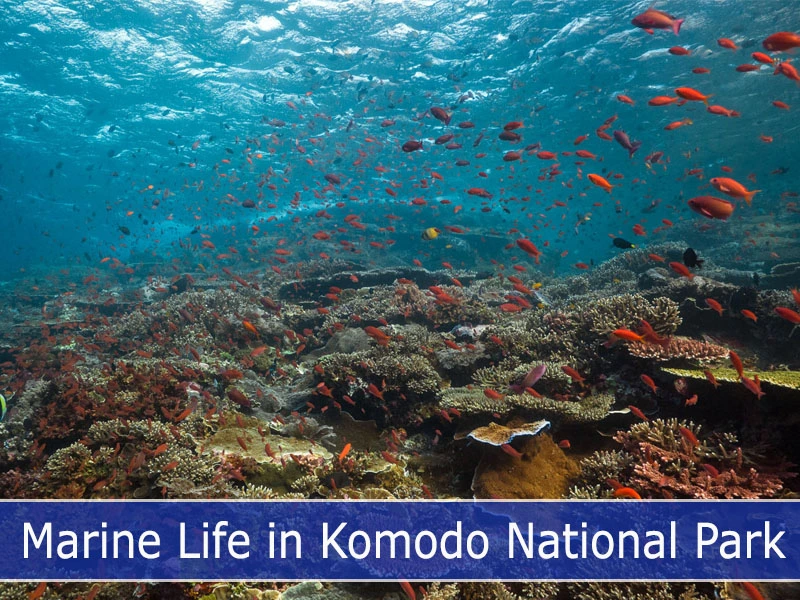
Marine Life in Komodo National Park
One of the main attractions of Komodo diving is the incredible biodiversity found within the park. The Manta Rays are of course the main attraction but here are some of the marine life divers can expect to encounter:
Manta rays: These gentle giants can be spotted at various dive sites, especially at Manta Point and Manta Alley.
Sharks: Reef sharks, such as blacktip, whitetip, and grey reef sharks, are commonly seen while diving in Komodo.
Turtles: Green and hawksbill turtles are frequently observed resting on the reefs or munching on coral.
Fish: Thousands of fish species, including schools of trevallies, barracudas, and colorful reef fish, can be found throughout Komodo National Park.
Critters: Macro enthusiasts will love Komodo diving for its variety of critters, such as nudibranchs, frogfish, and pygmy seahorses.
Best Time for Komodo Diving
Komodo diving is possible all year-round, but the best conditions will be found between the months of April and November. During this time, the water is calm, and visibility can reach up to 30 meters. Between December to end of February the rainy season comes with strong winds, big waves and bad visibility. But that is also the time when the Manta Ray migration takes place. So there are ups and downs to this.
However, divers should be aware that the park can get quite busy during the peak diving season from July to September.
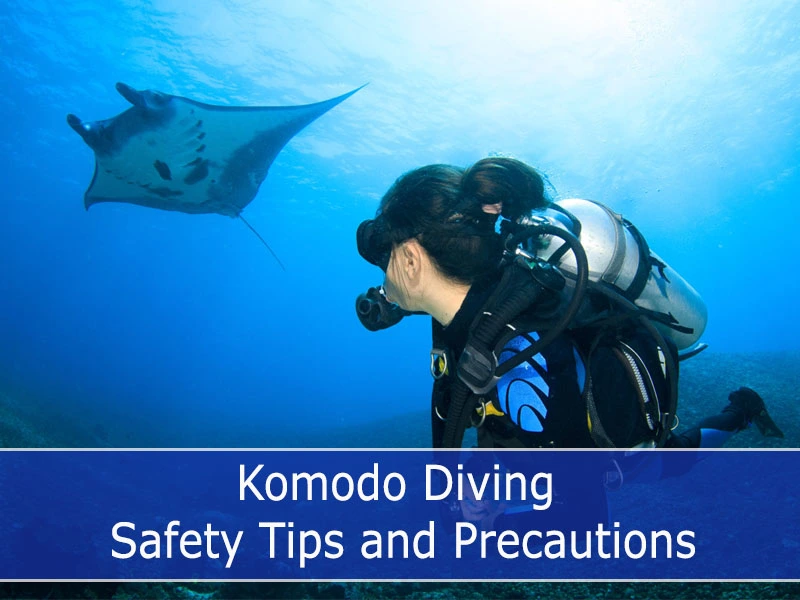
Komodo Diving Safety Tips and Precautions
While diving in Komodo is an incredible experience, one way to take it to the next level is through a Komodo liveaboard experience. It’s essential to prioritize safety, and fortunately, there are several dive centers in Labuan Bajo that offer liveaboard trips. These trips allow divers to spend multiple days exploring the breathtaking beauty of Komodo National Park while staying on a boat specially equipped for diving. In addition to the dive centers, there are also a couple of dive resorts available, alongside the popular hotels and resorts already present in Komodo.
Choose the right dive operator
Research and select a reputable dive operator that prioritizes safety and has experienced dive guides familiar with the local conditions. This is because the dive sites are sometimes difficult and require special well experienced guides.
In Komodo, we are present with Neptune Scuba Diving Komodo and our very own Komodo Resort, always ready to welcome you for an amazing Komodo diving experience.
Neptune Scuba Diving Komodo is a highly regarded dive operator in the Komodo region. With their expertise and dedication to safety, they have built a strong reputation among divers. Their team of experienced dive guides are well-versed in the local dive sites and can offer valuable insights and guidance during your dives.
Whether you are a beginner or an advanced diver, Neptune Scuba Diving Komodo can cater to your needs and provide you with a memorable and safe diving adventure.
Having a comfortable and convenient accommodation option can greatly enhance your diving experience. Komodo Resort, situated in the vicinity, offers a fantastic place to stay during your visit to the Komodo region. Their resort provides comfortable accommodations, excellent amenities, and easy access to dive sites.
Staying at Komodo Resort allows you to have a seamless experience, with the dive operator located nearby and ready to assist you with all your diving needs. You can enjoy the convenience of being just steps away from breathtaking dive sites and the beauty of Komodo National Park.
By choosing a reputable dive operator like Neptune Scuba Diving Komodo and staying at Komodo Resort, you can ensure that your Komodo diving experience is not only thrilling and memorable but also safe and well-organized.
Take the time to research and select the right dive operator that prioritizes safety and has a proven track record. With the right operator and accommodation, you can dive with confidence, explore the stunning underwater world of Komodo, and create lasting memories of your diving adventures.
Be aware of the currents
Komodo is known for its strong currents, which can change rapidly and often with even stronger down currents as often found in Batu Bolong. Always dive with a guide and follow their instructions to ensure your safety. This is a good moment to also mention that divers should always pay additional attention to the pre-dive briefings.
Carry appropriate safety equipment
Ensure you have a surface marker buoy (SMB), whistle and horn, and a dive computer to help you navigate and communicate in case of an emergency. The SMB is mandatory while the whistle and horn should be non-negotiable. In the extraordinary and unlikely case that you become separated from your dive group or dive boat, they will be your only means to be discovered.
Some dive centers or Liveaboards provide a diver GPS such as a Nautilus Life Line.
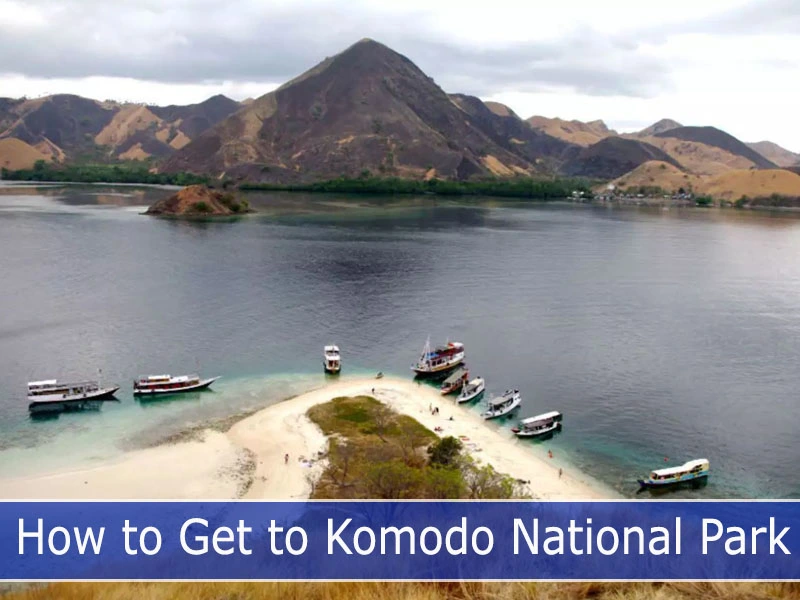
How to Get to Komodo National Park
Reaching Komodo typically involves flying from Bali, Jakarta or any other of the smaller cities such as Maumere, Ende or Kupang. The domestic flights to Labuan Bajo are sufficient and organized by the airlines Garuda Indonesia, AirAsia, Citilink, Batik Air and Lion Air.
Because the domestic airlines are famously known for last minute cancellations and delays, we recommend flying with Garuda or AirAsia as they generally are more reliable.
Accommodation and Other Activities
Finding accommodation in Komodo is easy as you will find big hotels and resorts such as: Ayana, Sudamala, or Plataran. There are also cheaper accommodation such as homestay which can be found in Labuan Bajo.
For divers, nature lovers and those interested in Komodo snorkeling, Neptune Scuba Diving, known for its excellent dive guide services, owns the famous Komodo Resort, placed conveniently on Sebayur Island, just at the entrance into the Komodo National Park.
Contact us for availability or information about Komodo diving.
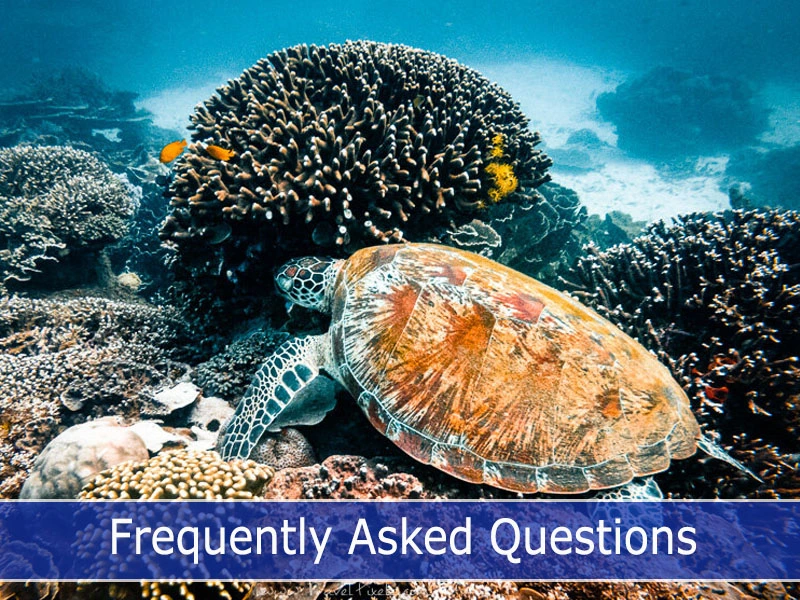
Frequently Asked Questions about Komodo Diving
What is Komodo diving?
Komodo diving refers to the scuba diving experiences around the Komodo National Park, a UNESCO World Heritage Site located within the Lesser Sunda Islands in Indonesia. The park is home to the famous Komodo dragon and boasts a diverse marine ecosystem, making it a popular destination for divers from around the world.
What marine life can I expect to see while diving in Komodo National Park?
The park is known for its rich marine biodiversity, including over 1,000 species of fish, 260 species of coral, manta rays, sharks, turtles, dolphins, whales, and even the occasional dugong. It is also a fantastic place to see macro life, with colorful nudibranchs, pygmy seahorses, and frogfish among the many creatures that can be found.
When is the best time to go diving in Komodo National Park?
The dive season in Komodo is year-round, but the best time to visit is generally during the dry season, which runs from April to November. The water visibility is typically better during this period, and sea conditions are more favorable for diving.
What are the water conditions like in Komodo National Park?
Water temperatures in Komodo can range from 68°F (20°C) in the south to 86°F (30°C) in the north. Visibility varies depending on the time of year and location but generally ranges from 16 to 98 feet (5 to 30 meters). Currents can be strong in certain areas, so it's essential to dive with an experienced guide.
Are there any specific dive sites that I should not miss?
Some popular dive sites in Komodo National Park include Castle Rock, Batu Bolong, Crystal Rock, Manta Point, and Cannibal Rock. Each site offers unique underwater landscapes and marine life encounters, so it's worth exploring as many sites as possible during your trip.
Do I need any specific certifications or experience to dive in Komodo National Park?
While there are dive sites suitable for beginners, it is recommended that divers have at least an Advanced Open Water certification due to the strong currents and challenging conditions often encountered in the area. Some dive operators may also require a minimum number of logged dives for certain sites.
Are there any safety precautions I should be aware of when diving in Komodo National Park?
Always dive with a reputable dive center and ensure you have a thorough dive briefing before entering the water. Pay attention to your guide's instructions regarding currents and safety procedures. Be aware of your surroundings and maintain a safe distance from potentially dangerous marine life, such as sharks and Komodo dragons.
What type of accommodation is available for divers in Komodo National Park?
There are various accommodation options available, including liveaboard boats, dive resorts, and hotels in nearby Labuan Bajo. Liveaboards are a popular choice as they allow divers to visit multiple dive sites and fully immerse themselves in the diving experience.
Can I see Komodo dragons while I'm on a diving trip?
Yes, many diving trips to Komodo National Park include a visit to one of the islands where Komodo dragons can be observed in their natural habitat. Always follow your guide's instructions and maintain a safe distance from these large reptiles.
How do I get to Komodo National Park for my diving adventure?
The nearest airport to Komodo National Park is Komodo Airport in Labuan Bajo, Flores. There are daily flights from Bali and Jakarta to Labuan Bajo. From there, you can join a liveaboard, book a private boat charter, or take a day trip to the park for your diving adventure.